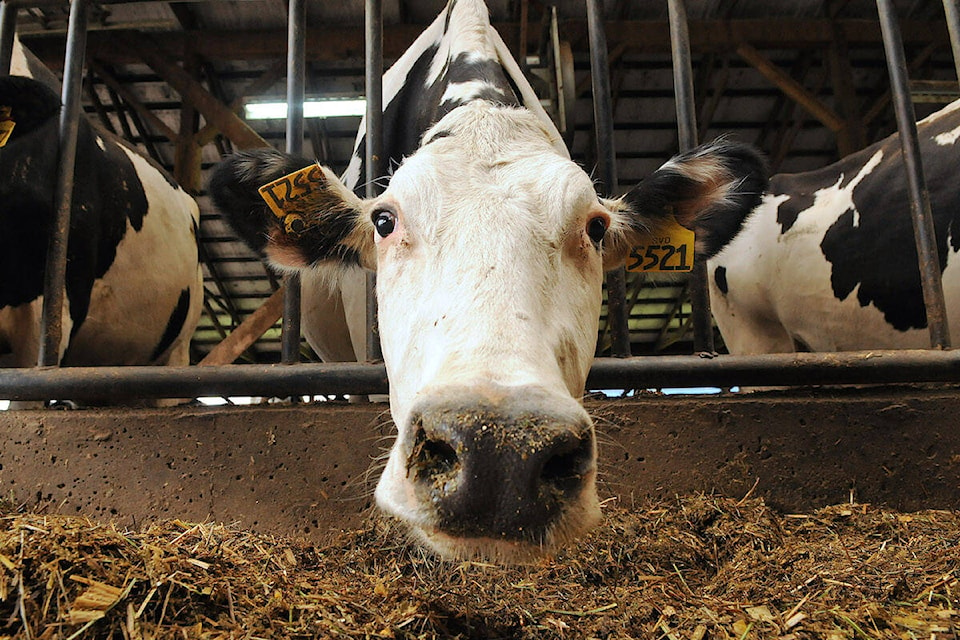The welfare of more than a million dairy cows across Canada was front and centre with key changes coming next year to the ‘Code of Practice’ for the care and handling of dairy cattle.
Reaction to the Code update released March 31 by the National Farm Animal Care Council and the Dairy Farmers of Canada, has been generally positive, with some saying changes to the standards can’t come soon enough.
Best practices for housing, feeding, handling, and pain control, as well as tweaks to requirements like increased calf socialization, were notable in the update.
Dairy farmer Chris Kloot, who is also a Chilliwack city councillor, said he welcomes the coming changes and says they reflect what’s been happening on the ground.
“With my own farm, and many other local dairy farmers that I know, updates in the code are consistent with practices already in place.”
For example the new Code requires more social contact between calves, and more movement for lactating and dry cows.
“Both are supported by science in promoting overall good animal welfare and reflect changing expectations of animal care,” Kloot said. “As the updated Code continues to evolve and comes into effect in April 2024, or later, consumers can be confident that animal care standards in this country are world-class with exceptionally high standards, and among the envy of many other countries.
“As a proud Canadian dairy farmer in Chilliwack, I have no concerns with the requirements and I view them as a positive step,” Kloot said.
Kristina Koehn Merchant, marketing and communications manager at Humane Canada, acknowledged the improvements, as well as pointing out a few areas that need work.
“Some notable advancements in this new Code include improved social interactions for dairy cattle and a path to eliminating tie stalls, as well as requirements for farmers to take action when they see signs their herd is not doing well overall.
“In short, these changes will better allow cows to be cows.”
There were however some key changes for which Humane Canada would have preferred to see quicker implementation.
Overall the 2009 Code of Practice for the care and handling of dairy cows will not be replaced until sections of the updated Code comes into effect in April 2024, and other parts much later.
“We are disappointed that the requirement allowing for calving to take place in loose areas that allow the cows to turn around does not come into effect sooner than 2029, which is six years from now,” the release from Humane Canada said.
Providing cows access to pasture is not required of dairy operators, but it is obviously a setting that allows for more natural living conditions.
“While this is an option that farmers can choose, they are not specifically required to provide this to all cows, even though cows are naturally motivated to graze on pasture.”
Regarding cull cows, transportation is a serious issue, as many cows suffer in the trips to slaughter after their milk production stage of life ends.
“We would have liked to see stronger language, and more action in general, to support the industry moving toward local slaughter for cull cows.
“We would also like to have seen requirements that cows kept in tie stalls be conditioned to withstand transport; their lifestyle of less movement and exercise does not prepare them for transportation conditions.
And finally Humane Canada would have preferred an earlier phase-out for continuous tethering of cows than four years from now.
“Given the climate change crisis, and the horrible disasters that have affected dairy farms in Canada, we were hoping for a dedicated chapter and specific requirements to address emergency preparedness, as is the case in the recently published NFACC Goat Code.”
RELATED: Dairy code of practice raises expectations for cattle care
The new Code will undoubtedly improve the lives the estimated 1.4 million dairy cows on farms in Canada, according to BC SPCA’s March 31 release.
The BC SPCA, along with nearly 6,000 individuals and groups were among those actively suggesting recommendations for Code changes.
For example, a requirement that would allow some farms to delay transitioning calves to group housing was removed, and a requirement for allowing cows in tie stalls more freedom was strengthened.
“Changes like these demonstrate the importance of speaking up for animals,” the BC SPCA said.
By 2031, farmers will need to house calves in pairs by four weeks of age.
“This will reduce stress and allow calves to develop social skills. This is an important change that will improve calf welfare on dairy farms across Canada.”
The Dairy Farmers of Canada see all the efforts leading to enhanced care at the national level.
“Canadian dairy farmers already follow some of the most stringent standards in the world, and the new Code of Practice will help them continue to provide the best in animal care while staying consistent with our industry’s history of continuous improvement,” says Pierre Lampron, President of DFC.
“This commitment to quality and care means dairy farmers are always looking to stay ahead of the curve and improve their practices, reflecting the most recent science on the welfare of their animals.”
RELATED: Reaction to abuse charges for Chilliwack dairy farm
Do you have something to add to this story, or a news tip? Email:
jennifer.feinberg@theprogress.com
@CHWKjourno
Like us on Facebook and follow us on Twitter.



